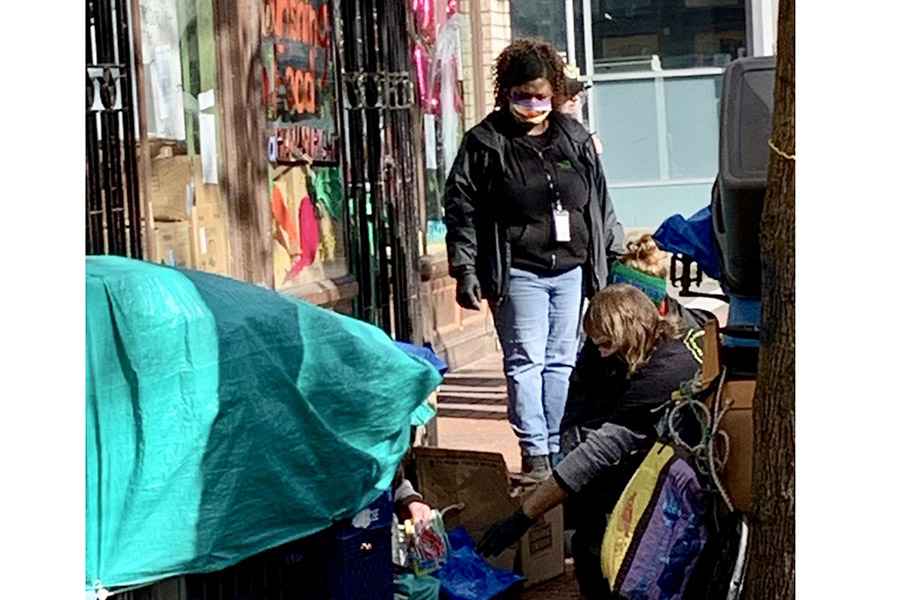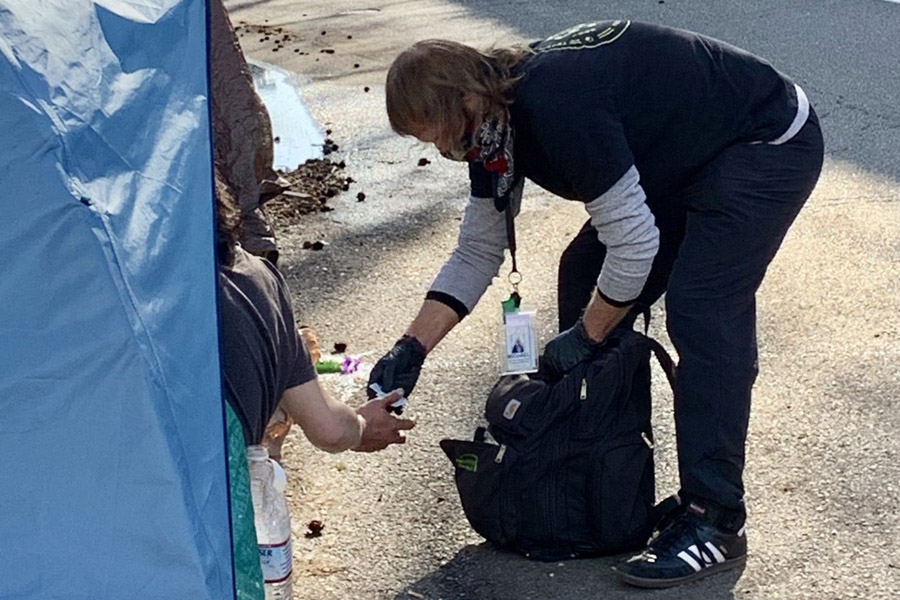As nonprofits provide essential services during the COVID-19 epidemic, grantmaking organizations fight to keep them running.
For a month now, George Devendorf, executive director of Transition Projects, has had to self-isolate from his family.
He has kept the same level of social distancing at home that many reserve for public places, such as the grocery store.
“The hardest part is holding up my hand and telling my son he can’t hug me or come close to me,” he says. “But all of us are healthy at this point. I’m very grateful for that.”
Devendorf’s organization supports more than 10,000 people experiencing homelessness throughout Oregon by providing shelter, housing placement, employment and other forms of assistance.
The work is essential. It is also high risk. People who are homeless are considered high risk of contracting the coronavirus because they face problems self-isolating among other reasons. Individuals who work closely with them must take extra precautions around their own families.

Transition Projects passes out food to the homeless. Photo: George Devendorf
Many nonprofits have continued their work during the COVID-19 outbreak, with some adjustments. Self Enhancement, a mentorship nonprofit for children of color, and SMART Reading, an early childhood development nonprofit, have moved their courses online. Meals on Wheels has had to reduce weekly visits, but has begun a “Friendly Chat” program to have wellness calls with seniors.
Above all, funding remains the most pressing issue to keep staff and operations going.
Jim White, executive director of the Nonprofit Association of Oregon, says many nonprofits are facing sharp declines in revenue. A clunky rollout of government assistance at the federal level has caused anxiety over whether the funds would be readily available.
“By and large, earned revenues are the largest source of funding nonprofits get, and you can imagine how social distancing is having an impact on that,” says White. “The second largest source of funds are government grants, and they are having difficulty getting money out the door. A lot of our work last week has been getting information to people about what’s real and what’s rumor.”
The federal government made money available to nonprofits through the Small Business Association’s Paycheck Protection Program (PPP) on April 3. The program provides $376 billion in loans to help employers with payroll.
Unfortunately, the rollout was marred by confusion. For one, the application for these loans had to come from the lending bank, rather than the organization itself, which caused more than a few problems, according to White.
“Some lenders weren’t accepting applications until they got instructions to do so. Others were accepting applications but they were using outdated instructions,” he says. “Over here we called it ‘PPP pandemonium.’”
Another issue when applying for funds, says White, is that the uncertainty felt by nonprofits causes them to apply for as many grants as they can, leaving grantmaking administrators flooded with requests
Mercy Corps initiated the COVID-19 Resilience Fund, which the international humanitarian organization spends on global efforts to combat coronavirus. The organization established peer-to-peer fundraising networks online to support its efforts, and while overall giving might decrease as donors reduce their spending, the nonprofit created other ways for corporations and individuals to get involved.
“We are shifting focus to the large influx of business support inquiries we are receiving,” says Lynn Hector, media and communications manager at the Mercy Corps Portland office. “We are using our expertise in business services to provide education for local businesses on pivoting operations and where to find funding.”
The organization has a MicroMentor platform that connects concerned business owners with mentors from a long list of corporate partners.
Community foundations with a broad network of donors have been able to react nimbly to the COVID-19 crisis.
“Community philanthropy is pretty unique compared to other foundations,” says Stephanie Swanson, vice president of communications for the Oregon Community Foundation. “We are being advised by a very strong network of volunteers, community leaders and donors, instead of by a board. It lets us be more active.”
In the first month of the crisis, the foundation mobilized $6 million through its network of more than 2,000 individual donors to develop the Oregon Community Recovery Program. The foundation has dispersed more than $4 million to Oregon nonprofits so far, giving preference to organizations serving underprivileged communities.
Chief community impact officer Sonia Worcel says the broad network of support for the organization has allowed it to move quickly, and that the funding response from donors has been good.
“We wanted to get money out the door as quickly as possible,” says Worcel. ”Our first round of grants was to community action agencies, emergency relief funds and to culturally-specific organizations to help with things like food and rent. This week our focus was on supporting the homeless population.”
One of the organizations it helped to fund was Transition Projects.
“We just heard back from the Oregon Community Foundation, and they responded positively to our request,” says Devendorf. “The challenge for us now is not getting bogged down in the details and looking just around the corner instead of way off into the future.”
Devendorf says that while there is not much of a bright side to the pandemic, it has helped keep the lines of communication open between nonprofits and grantmaking organizations, as well as between organizations that serve similar populations.
“I’ve gotten very close to my peers, my fellow executive directors, says Devendorf. “It’s important because many of the people we serve are served by multiple agencies. One day they might be coming through your door, and the next day they could be coming through mine.”
To subscribe to Oregon Business, click here.







